I’m not too sure what to expect when I enter the “wormhole” to the Metaverse Playground.
I’ve done my homework on the event, and I’ve tried my hand in VR games and I’ve attended one virtual art opening (due to the pandemic), but I’m still unsure of the loaded word “metaverse” — especially in light of Facebook’s recent, much-maligned embracement of the term, which was first coined in a 1992 dystopian novel.
The Metaverse Playground is the Expo portion of this year’s Taiwan Creative Content Fest, featuring a diverse array of immersive events and other showcases and live activities. The festival, which runs until Sunday, also features livestreamed forums, a Next Academy side-exhibition on the future of content creation and Garden Mingle, an interactive, futuristic outdoor performance and a concert that begins tonight.
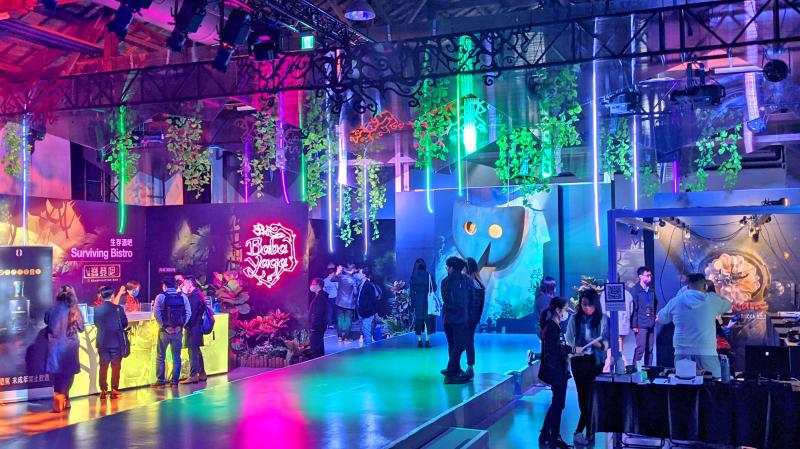
Photo: Han Cheung, Taipei Times
Expo curator Samuel Wang (王騰崇) says that the metaverse is more than just cold digital technology and applications. There’s no need to be nervous, as people were averse to smartphones when they first came out, too, he argues.
“I see the metaverse as a way for people to examine the universe within themselves. Since VR content moves between reality and virtuality, I think this exhibition shows how one’s avatar can journey between the two realms and find a balance.”
Just like how our dreams can be used to deal with our real lives, the metaverse can also be a chance to look within and redefine the way we live. “It doesn’t need to be like the nihilism of cyberpunk. It’s something that can be faced positively,” he says.
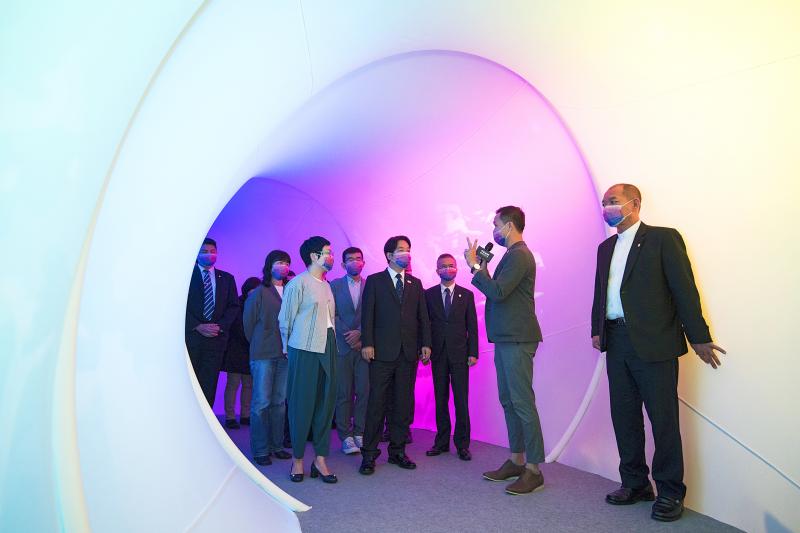
Photo courtesy of Taiwan Creative Content Agency
ENJOYING THE PLAYGROUND
The show’s first half mostly features VR and other types of cutting-edge visual entertainment, from 360 movies to interactive, immersive experiences as well as more art-oriented projects, which are becoming increasingly dynamic.
For example, Huang Hsin-chien’s (黃心健) latest project Samara Ep 1 (輪迴), which won Best VR Story at the Cannes XR showcase, is a step up from his previous work; the scenes are more vivid, the movement is smoother and more exciting and the viewer can use their voice to trigger certain images as well. Still, storytelling is key, and Huang’s tale of humans evolving over hundreds of millenia as they leave a devastated earth to find a new home is a relevant and compelling one.
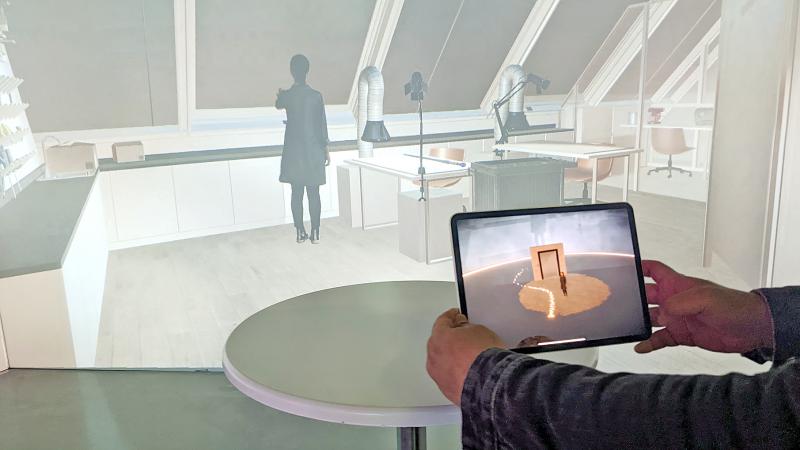
Photo: Han Cheung, Taipei Times
Not all projects rely purely on 3D animation, and it’s encouraging to see the combination of physical crafts and VR. As a history buff, I enjoyed the four-minute video on the changes in Taipei’s railroad system over a century, bringing to life actual miniature models belonging to the Kaohsiung Museum of History. The VR content is interspersed with old photos, which is a wonderful way to make education fun.
The VR film The Sick Rose (病玫瑰) by HTC Vive Originals is also such a combination. Set during a pandemic in a fantastic Taiwan-esque landscape, it employs old-school stop-motion animation with traditional dough figurines. This is a highly effective way to combine tradition and the latest technology, and could be important in keeping dying arts alive in the future.
On the other side of the exhibition, which focuses on interactive entertainment applications, a woman using a motion sensitive smart glove to control a Taiwanese hand puppet catches my eye. This is part of a larger venture between the Seden Society Puppet Theater Foundation (西田社布袋戲基金會) and National Yang Ming Chiao Tung University that attempts to combine AI and other tech to promote and preserve the art of puppetry.
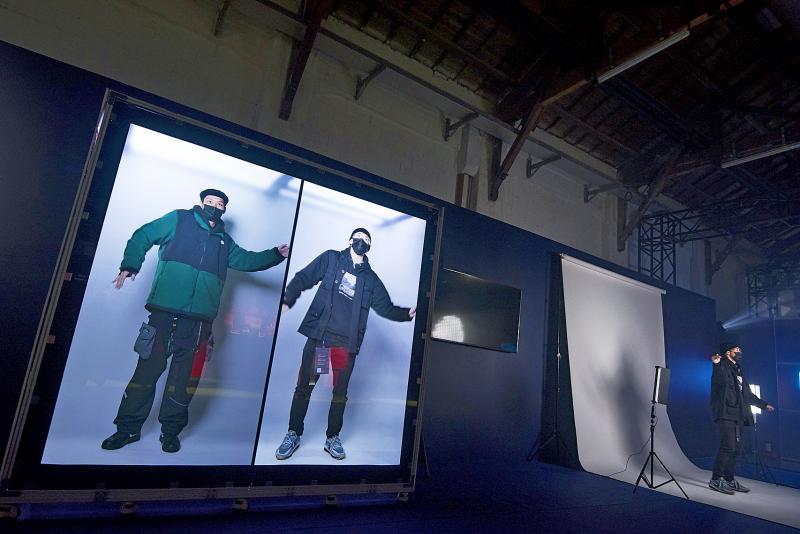
Photo courtesy of Taiwan Creative Content Agency
In addition to getting more young people interested in puppetry, the glove can capture the old puppet masters’ hand motions, recording their skills as the art form becomes rarer by day.
Another intriguing experience is singing karaoke in a virtual booth, which can feature up to 40 users from anywhere in Taiwan. I still prefer in-person interaction, but I can see the appeal — it’s clean, convenient and perfect for a pandemic or long distance friendships. In four months, organizers say, they have amassed over 2,000 users.
IS THIS THE FUTURE?
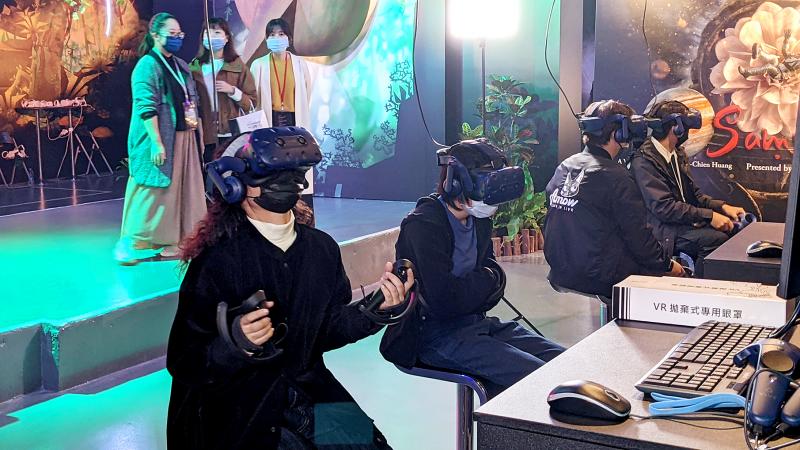
Photo: Han Cheung, Taipei Times
However, it still feels that there are limitations to these magical tools as far as popularization goes, at least for now. After all, the main goal of expos is to display the possibilities for potential users, or creative and business partners.
For example, due to the limited number of headsets, virtually all the immersion events were booked before the event started. Plus, one can’t really experience that many products in one go as the devices are still slightly uncomfortable (especially for someone wearing glasses) and some of the content can make people dizzy.
A lot of these productions can only be displayed at exhibitions or film festivals, either due to logistics, physical space or system requirements. For instance, people cannot sing real-time duets in virtual karaoke unless they both have 5G. A neat-looking interactive AR film that only requires a tablet cannot be played at home yet due to massive file size.
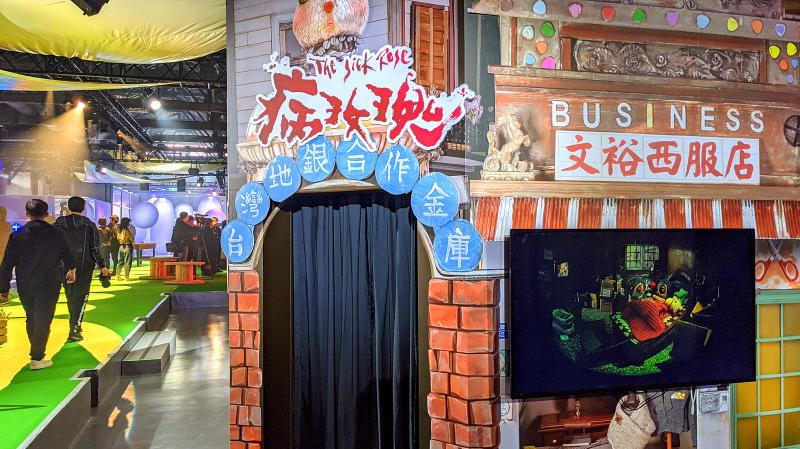
Photo: Han Cheung, Taipei Times
But there is progress. For example, Kaohsiung’s VR Film Lab can seat up to 30 people per screening since 360 degree movies require less space than interactive ones. During the annual Kaohsiung Film Festival, they also allow people to rent headsets so they can get used to watching movies with the device in their home. One day, the staff tells me, they hope that it will be common for every household to own one.
Wang says he thought it would still take some time for the public to really embrace metaverse technology, but he was surprised at how quickly the time slots for each experience was booked long before the event began — especially compared to last year’s expo. Accessibility has also been boosted with headsets getting cheaper in recent years.
He remains optimistic about the future, noting that with more tech giants such as gaming company Roblox and Facebook joining the fray, both the software and hardware will improve quickly, not unlike when Apple introduced the iPhone and App Store more than a decade ago.
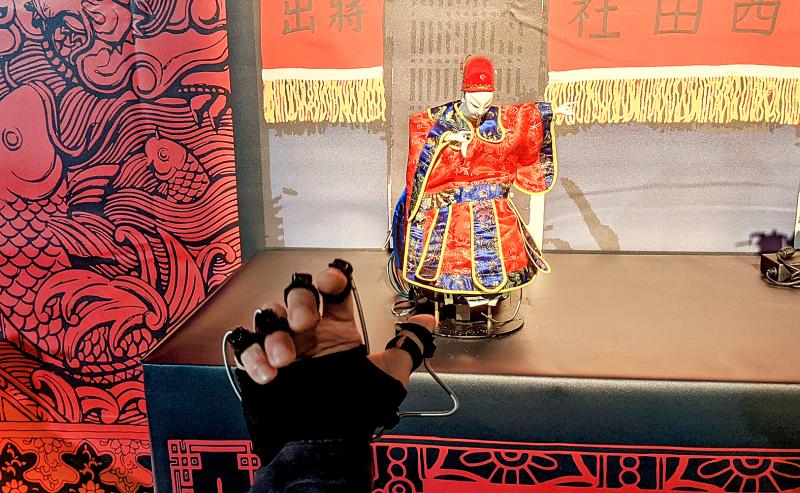
Photo: Han Cheung, Taipei Times
For those who missed out in signing up for the VR events, Wang says there’s still much to see as VR content only consists of about 60 percent of the expo. There are data-driven art projects, for instance, such as the Winds of Taipei digital painting created from a year’s worth of local wind information, and Signal, an interactive, immersive art piece drawing from real-time COVID-19 diagnosis data from various countries.
“We want to show that the metaverse is more than just VR content,” he says.
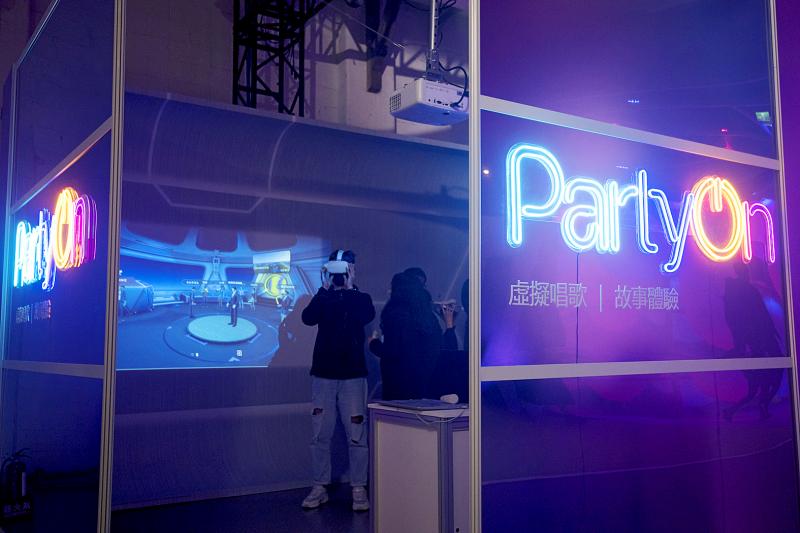
Photo courtesy of Taiwan Creative Content Agency

Most heroes are remembered for the battles they fought. Taiwan’s Black Bat Squadron is remembered for flying into Chinese airspace 838 times between 1953 and 1967, and for the 148 men whose sacrifice bought the intelligence that kept Taiwan secure. Two-thirds of the squadron died carrying out missions most people wouldn’t learn about for another 40 years. The squadron lost 15 aircraft and 148 crew members over those 14 years, making it the deadliest unit in Taiwan’s military history by casualty rate. They flew at night, often at low altitudes, straight into some of the most heavily defended airspace in Asia.

This month the government ordered a one-year block of Xiaohongshu (小紅書) or Rednote, a Chinese social media platform with more than 3 million users in Taiwan. The government pointed to widespread fraud activity on the platform, along with cybersecurity failures. Officials said that they had reached out to the company and asked it to change. However, they received no response. The pro-China parties, the Chinese Nationalist Party (KMT) and Taiwan People’s Party (TPP), immediately swung into action, denouncing the ban as an attack on free speech. This “free speech” claim was then echoed by the People’s Republic of China (PRC),

Many people in Taiwan first learned about universal basic income (UBI) — the idea that the government should provide regular, no-strings-attached payments to each citizen — in 2019. While seeking the Democratic nomination for the 2020 US presidential election, Andrew Yang, a politician of Taiwanese descent, said that, if elected, he’d institute a UBI of US$1,000 per month to “get the economic boot off of people’s throats, allowing them to lift their heads up, breathe, and get excited for the future.” His campaign petered out, but the concept of UBI hasn’t gone away. Throughout the industrialized world, there are fears that

Like much in the world today, theater has experienced major disruptions over the six years since COVID-19. The pandemic, the war in Ukraine and social media have created a new normal of geopolitical and information uncertainty, and the performing arts are not immune to these effects. “Ten years ago people wanted to come to the theater to engage with important issues, but now the Internet allows them to engage with those issues powerfully and immediately,” said Faith Tan, programming director of the Esplanade in Singapore, speaking last week in Japan. “One reaction to unpredictability has been a renewed emphasis on